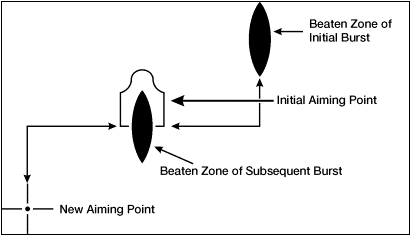|
Performance Steps
|
|
1. Assume a suitable firing position. Based on your situation, assume a firing position that will
allow you to observe and engage
targets, but reduce your exposure to
enemy fire.
|
a.
Prone position (figure 071-313-3454-1).
|
|

Figure 071-313-3454-1.
Prone position (tripod mount)
|
b.
Sitting position (figure 071-313-3454-2).
|
|

Figure 071-313-3454-2.
Sitting position (tripod mount)
|
c.
Standing position (figure 071-313-3454-3).
|
|

Figure
071-313-3454-3.
Standing position (tripod mount)
|
|
d.
Standing position for
cupola-mounted gun (figure 071-313-3454-4).
|
|

Figure 071-313-3454-4.
Standing position (cupola mount)
|
e.
Standing position for
high-mobility, multipurpose wheeled
vehicle (HMMWV)-mounted gun (figure 071-313-3454-5).
|
|

Figure 071-313-3454-5.
Standing position (HMMWV mount)
|
|
2. Obtain the correct sight picture.
|
a.
Sight alignment.
Center the front sight post in
the peep sight (figure 071-313-3454-6).
|
|

Figure 071-313-3454-6.
Correct sight alignment
|
b.
Sight picture. Place top center of front sight blade at bottom center of
intended target (figure 071-313-3454-7).
|
|

Figure 071-313-3454-7.
Correct sight picture
|
|
3. Apply the correct engagement technique based on
target type (figure 071-313-3454-8).
|
|

Figure 071-313-3454-8.
Techniques of fire with respect to the
gun
|
a.
Use the correct gun
manipulation technique.
|
(1)
Fixed fire. Refers to fire delivered against a point target.
Only one aiming point is
necessary, with little or no
manipulation of the gun.
|
(2)
Traversing fire.
Refers to fire distributed
against a wide target, requiring
successive changes in the gun
direction.
To distribute fire laterally,
use the T&E mechanism to traverse
the gun left or right.
|
(3)
Searching fire.
Refers to fire delivered
against a deep target or a linear
target with depth by successively
changing elevation.
To distribute fire in depth,
use the T&E mechanism to move the
muzzle of the weapon up or down.
|
(4)
Traversing and searching
fire.
Refers to fire delivered in
width and depth by successive changes
in direction and elevation.
Use this type of fire against a
target whose long axis is oblique to
the direction of fire.
|
(5)
Swinging traverse.
Refers to fire delivered
against targets that require major
changes in direction but little or no
change in elevation.
Loosen the traversing slide
lock enough to swing the gun
laterally.
|
(6)
Free gun. Refers to fire delivered against moving targets that must
be rapidly engaged with fast changes
in direction and elevation.
To fire free gun, remove the
T&E mechanism.
|
b.
Correctly apply fire to
engage specific targets.
|
(1)
Point target. Engage point targets with fixed fire using a single aiming
point (figure 071-313-3454-9).
|
|

Figure 071-313-3454-9.
Point target
|
(2)
Linear target. Initially aim at the midpoint of the target.
Traverse fire to one flank and
then to the other to cover the entire
target (figure 071-313-3454-10).
|
|

Figure 071-313-3454-10.
Linear target and one gun
|
(3)
Linear target with depth.
Initially aim at the midpoint
of the target, unless another portion
of the target is more critical or
presents a greater threat.
Traverse and search to the
flank closest to your position, then
back to the other flank, so you cover
the entire target (figure 071-313-3454-11).
|
|

Figure 071-313-3454-11.
Linear target with depth
|
(4)
Deep target. Initially aim at the midpoint of the target, unless another
portion of the target is more critical
or presents a greater threat.
Search down to the near end,
then search up to the far end (figure 071-313-3454-12).
|
|

Figure 071-313-3454–12. Deep target
|
(5)
Area target. Initially aim at midpoint of the target area.
Traverse and search to either
flank, then traverse and search to the
opposite flank (figure 071-313-3454-13).
|
|

Figure 071-313-3454-13.
Engagement of area targets
|
|
4. Observe fire and adjust the aiming point to place
effective fire on the target.
|
a.
Observation of fire.
Observe bursts of fire by
noting tracers in flight or the strike
of the rounds in the target area.
|
b.
Adjusted aiming point.
Adjust fire quickly without
adjusting the sight.
If the initial burst misses the
target, rapidly select a new aiming
point the same distance from the
center of impact of the initial burst
but in the opposite direction.
Fire a second burst (figure 071-313-3454-14).
|
|

Figure 071-313-3454-14.
Adjusted aiming point method
|
|
5. Fire on the targets until they are all destroyed,
or until you receive an order to cease
fire.
|